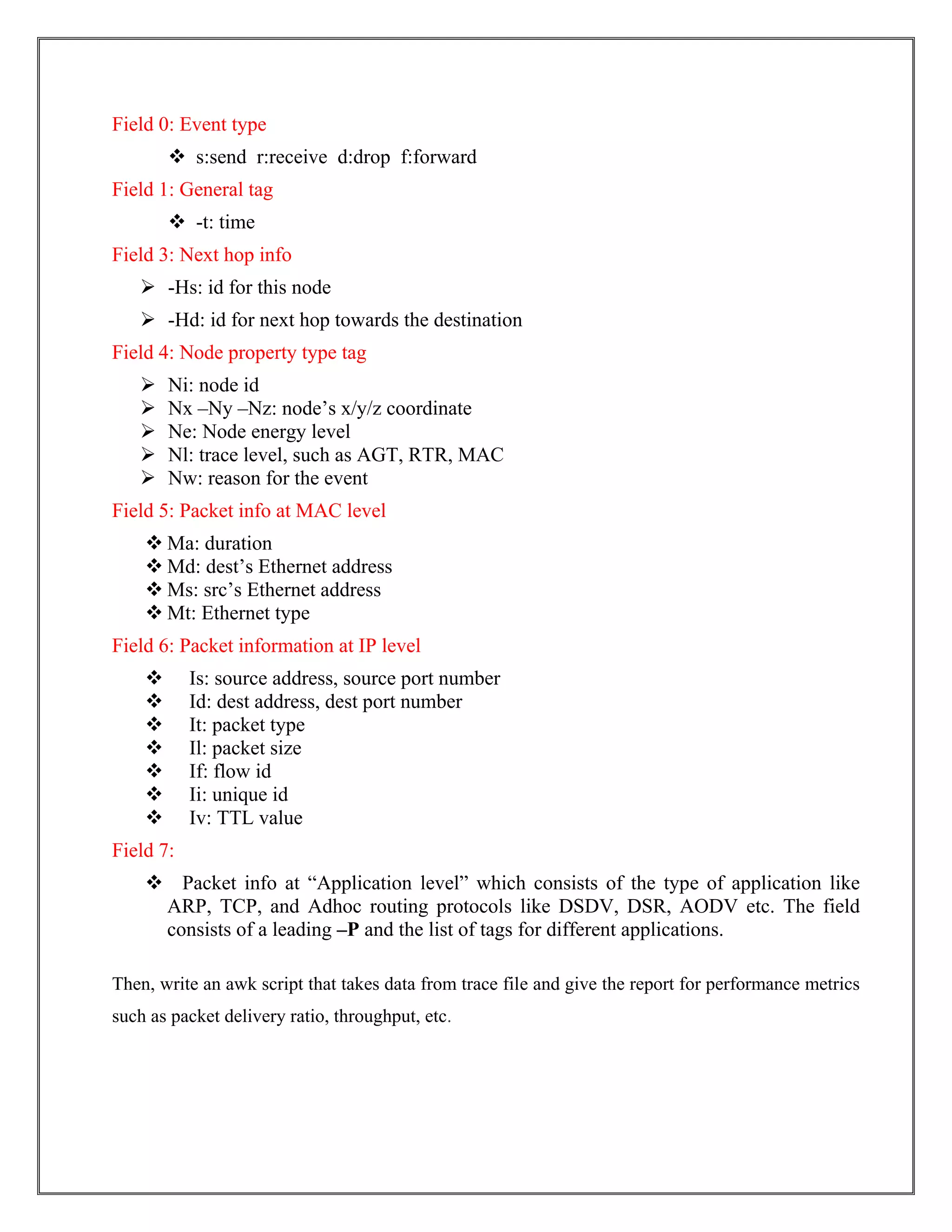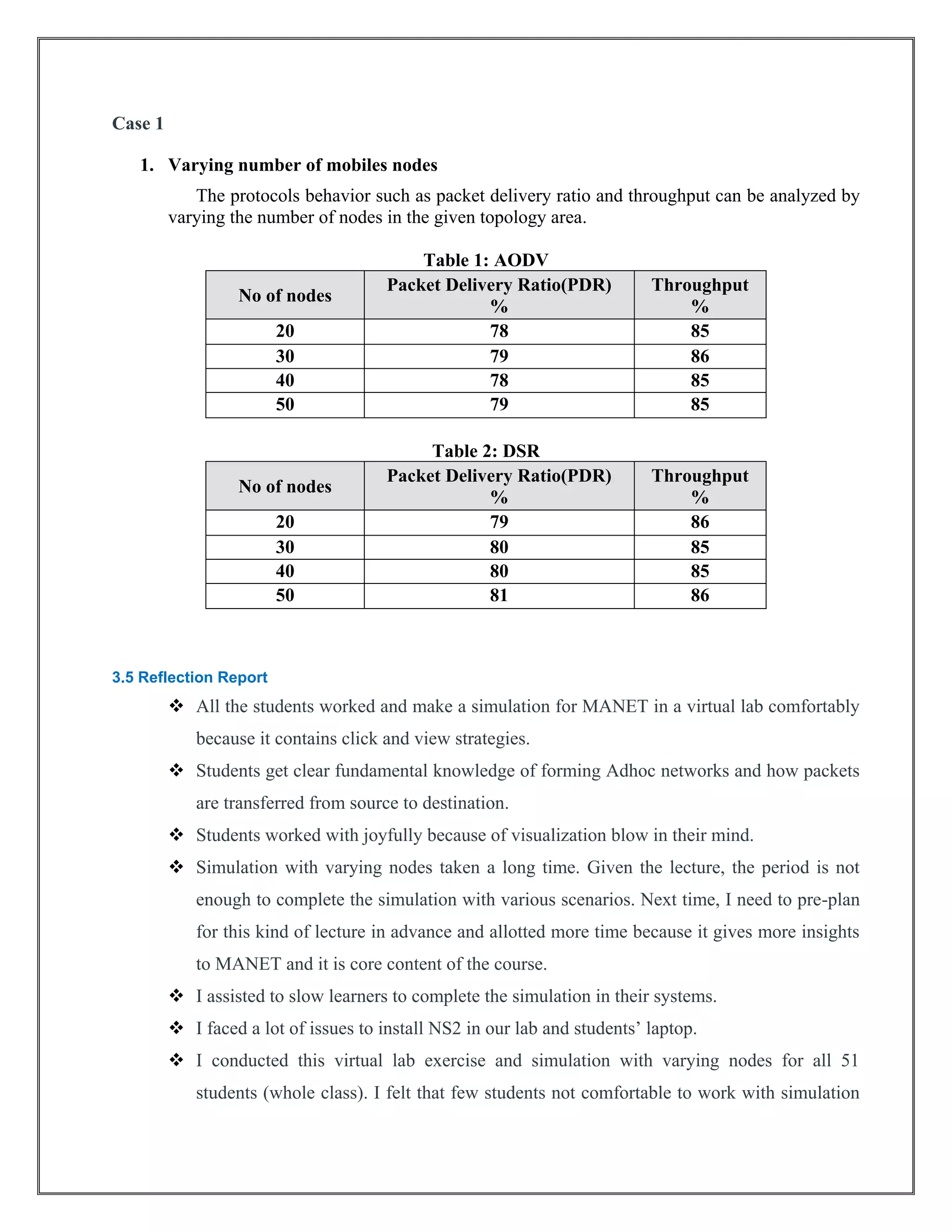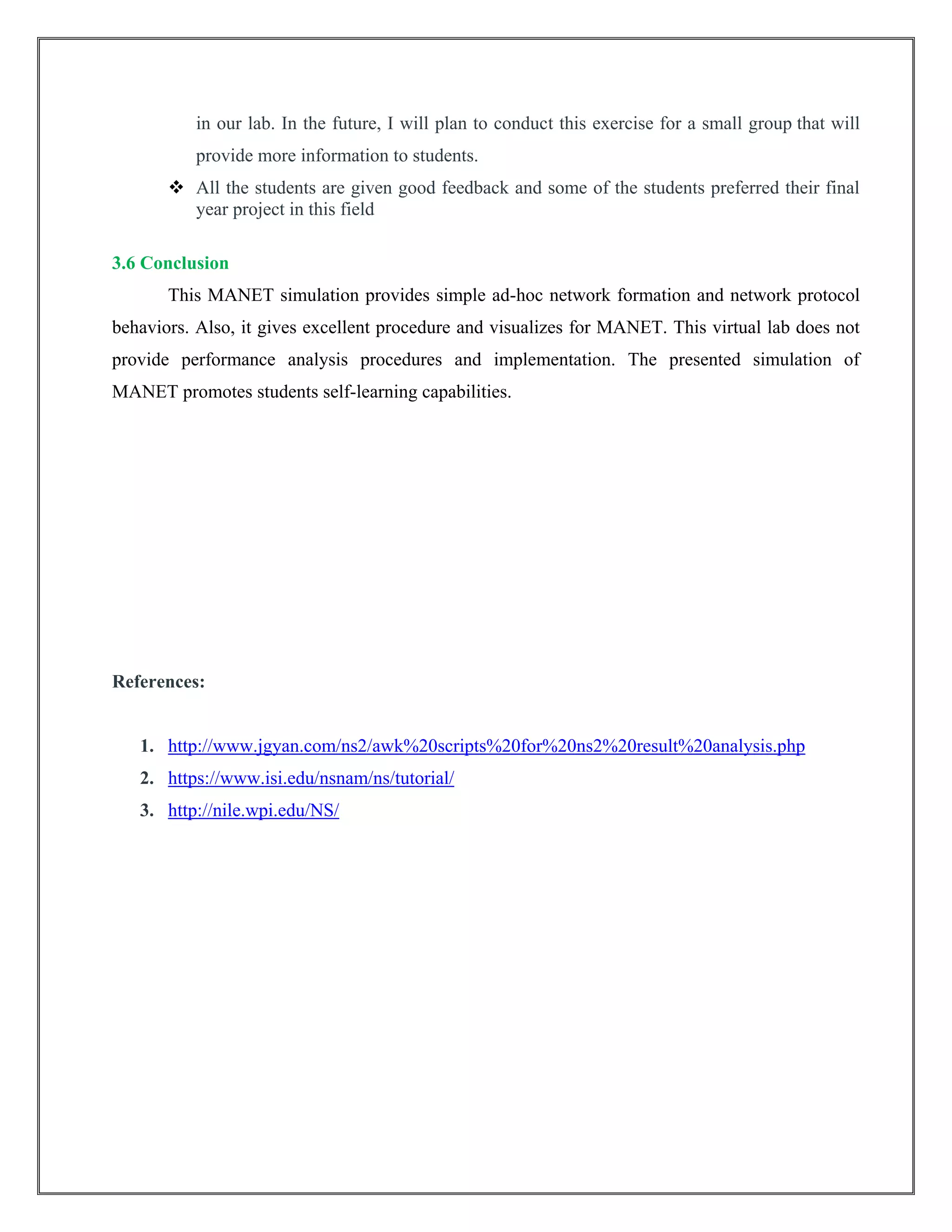The document describes a virtual lab simulation for analyzing routing protocols in mobile ad hoc networks (MANETs). It includes:
1) Objectives to design and simulate MANETs using NS-2 and analyze protocols like DSR and AODV.
2) A description of how NS-2 allows visually simulating and designing MANETs to see packet movement and how packets are transferred between nodes.
3) Instructions for performing a MANET simulation experiment in the virtual lab, including setting up a network with four nodes and observing how routes are disrupted and rebuilt when nodes move.
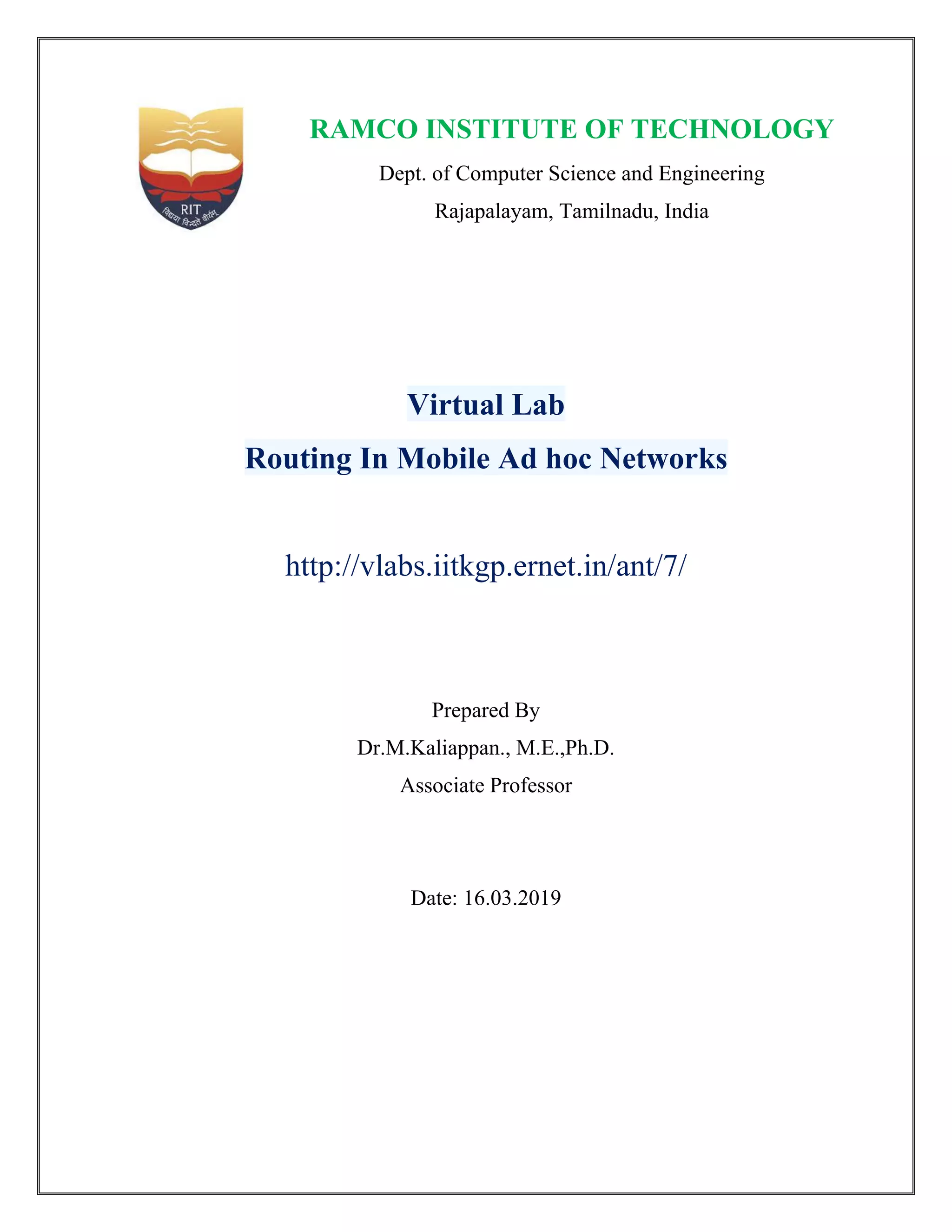

![3. Manual
3.1 Introduction.
The prime goal of this simulation is setup MANET with various routing protocols like
AODV, DSR, and DSDV. The simulation is written by TCL script [2]. The network performance
is analyzed by trace file. The trace file is generated automatically after the simulation is completed.
The trace file contains all activities that happened during the simulation and it recorded all the data
based on the event. This simulation shows the MANET setup, how a packet is transferred from
source to destination, what happens if the network gets disrupted, and how new routing path is
constructed after disruption or topology changes or node dead. This simulation is set up with four
mobile nodes and performs packet transfer and acknowledgment, route disruption and new route
formation. This simulation contains an introduction, theory, simulation, self-evaluation, procedure,
exercises and references section to get the insight of routing in MANET.
3.2 Instructions to perform a simulation experiment.
Visit to the following URL to perform a simulation for Routing in MANET.
http://vlabs.iitkgp.ernet.in/ant/7/
This page contains five tabs such as Introduction, theory, Simulation, Self-evaluation,
procedure, exercise and references to perform the MANET simulation.
Select the simulation tab.
Click button 1 to setup a MANET with four nodes. It shows how nodes form a network
automatically and perform packet transformation from node1 to node 4 with
acknowledgment. Figure 1 shows the simulation view.
.
Figure1 : Simulation view of four nodes](https://image.slidesharecdn.com/virtuallab-routinginmanet-191120071752/75/Virtual-lab-Routing-in-Mobile-Adhoc-Networks-3-2048.jpg)
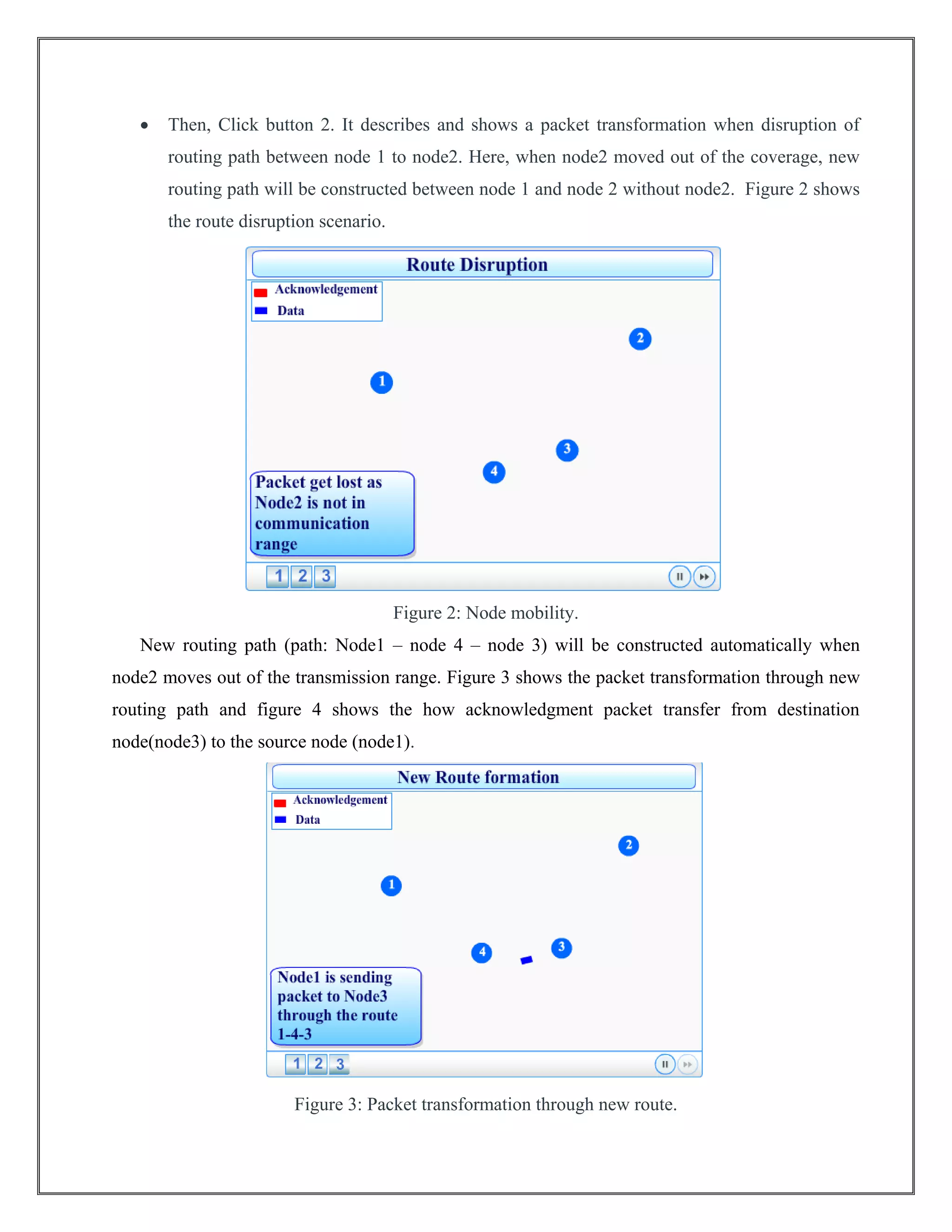
![Figure 4: Acknowledgement packet transformation
3.3 NS-2 INSTALLATION
NS2 can be installed in Linux environment [2]. Installation steps are given below.
Copy ns-allinone-2.34.tar.gz package to /root folder
Right click & do extract here
It will create ns-allinone-2.34 folder
Open the terminal and go to ns-allinone-2.34 folder
cd /root/ ns-allinone-2.34
To install type the command
./install
Open another terminal : set the environment variable open the /etc/profile file
gedit /etc/profile
Enter these variable in end of profile
export PATH=$PATH
export LD_LIBRARY_PATH=
export TCL_ LIBRARY=
Copy the value of PATH, LD_LIBRARY_PATH, and TCL_LIBRARY environment variables and
paste it in /etc/profile file.](https://image.slidesharecdn.com/virtuallab-routinginmanet-191120071752/75/Virtual-lab-Routing-in-Mobile-Adhoc-Networks-5-2048.jpg)
![3.3.1 Example:
set the environment variable
export PATH=$PATH:/root/ns-allinone- 2.34/tcl8.4.15/unix:/root/ns-allinone-
2.34/tk8.4.15/unix: /root/ns-allinone-2.34/bin
export LD_LIBRARY_PATH=/root/ ns-allinone-2.34/lib: /root/ns-allinone-
2.34/otcl-1.13
export TCL_ LIBRARY=/root/ns-allinone-2.34/tcl8.4.15/library
3.4 Frequent Ask Questions and answers.
1. How nodes can be increased in simulation?
2. How can set the node property and routing protocol in same MANET scenario?
3. How can we analyse the performance of the MANET?
4. How can develop, design and implement new protocol for our research?
3.4.1 Answer
1. How nodes can be increased in simulation?
We write a TCL script in NS2 for MANET simulation. We can increase number of nodes
using the following scripts.
#Create six nodes
for {set i 0} {$i < 6} {incr i} {
set n($i) [$ns node]
}
#Create links between the nodes
for {set i 0} {$i < 6} {incr i} {
$ns duplex-link $n($i) $n([expr ($i+1)%7]) 1Mb 10ms
DropTail
}](https://image.slidesharecdn.com/virtuallab-routinginmanet-191120071752/75/Virtual-lab-Routing-in-Mobile-Adhoc-Networks-6-2048.jpg)
![#Code for creating specific number of nodes
for {set i 0 } {$i < val(nn)}{incr i} {
set node_($i) [$ns_ node]
}
#Define a node position randomly
for {set i 0}{$i < $val(nn)}{incr i}{
$ns_ initial_node_pos $node_($i) 30
}
2. How can set the node property and routing protocol in same MANET scenario?
The following TCL scripts used to node setting and routing protocol for MANET.
# node configuration
$ns_ node-config - adhocRouting AODV
- llType LL
- macType Mac/802_11
- ifqType $qtype
- ifqLen 50
- antType Antenna/OmniAntenna
-propType Propagation/TwoRayGround
- phyType Phy/WirelessPhy
- channelType Channel/WirelessChannel
- topoInstance $topo
- agentTrace ON
- routerTrace ON
- macTrace OFF
3. How can we analyse the performance of the MANET?
The performance metrics such as hop-count, packet delivery ratio and end-to-end delay used
to analyses the MANET performance. The simulation result provides a trace file that contains the
activities of each node based on the event. The trace file format is as follows.
s –t 163.001503520 –Hs 0 –Hd -2 –Ni 0 –Nx 300.00 –Ny 500.00 –Nz
0.0 –Ne -1.000000 –Nl AGT –Nw --- –Ma 0 –Md 0 –Ms 0 –Mt 0 –Is
0.0–Id 2.0 –It cbr –Il 200 –If 1 –Ii 77 –Iv 32 –Pn cbr –Pi 32 –Pf 0 –Po 0](https://image.slidesharecdn.com/virtuallab-routinginmanet-191120071752/75/Virtual-lab-Routing-in-Mobile-Adhoc-Networks-7-2048.jpg)
